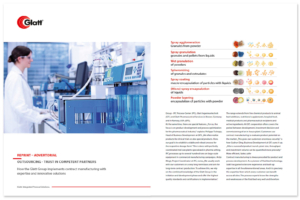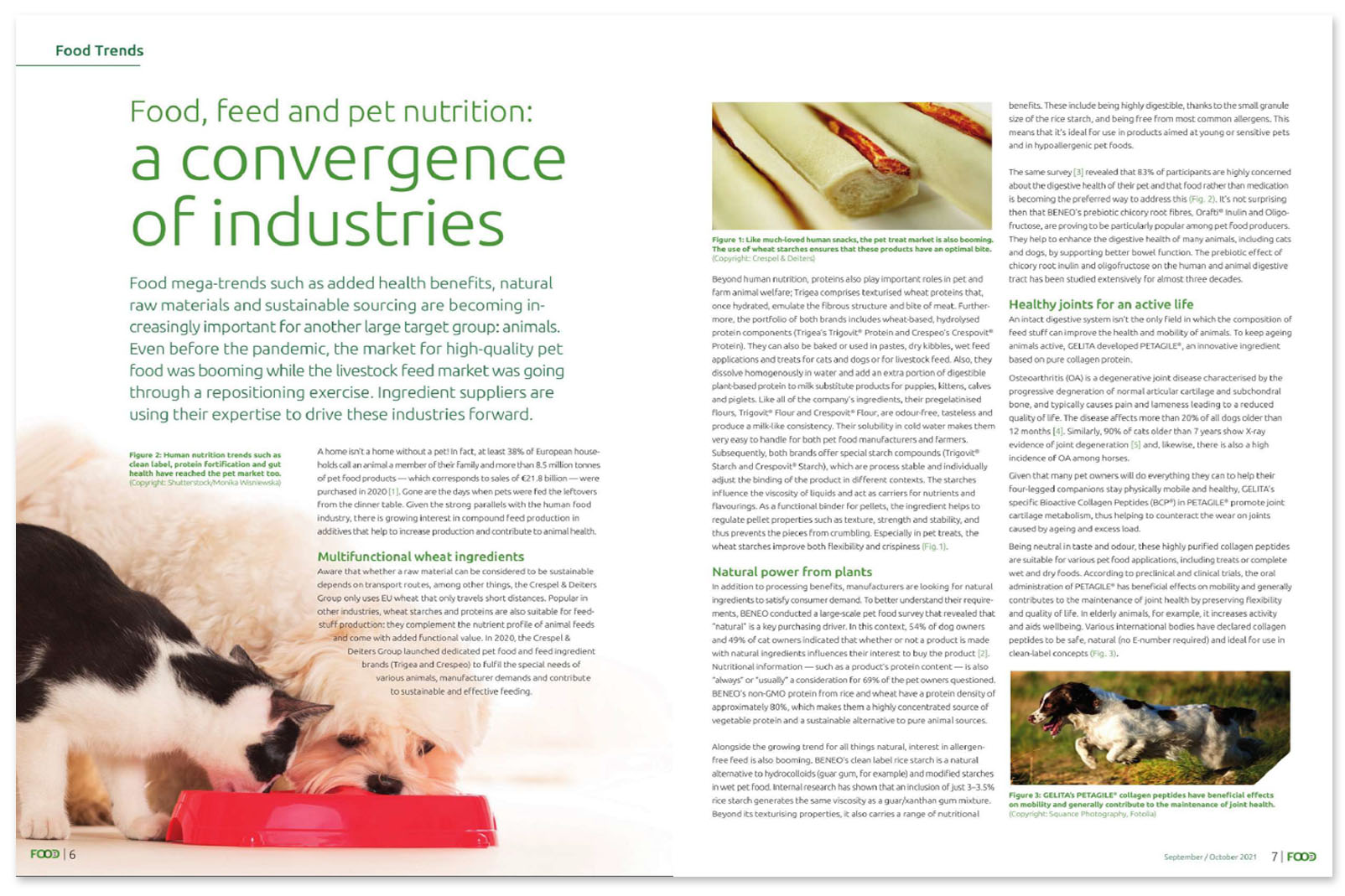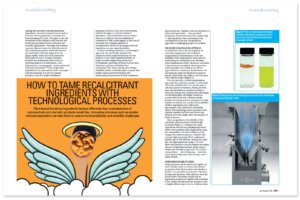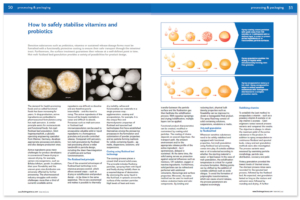Customised enzymes for optimal animal feed mixes
Technical processes improve the product properties
Feeds need enzymes that work optimally as well as being temperature-stable and storable. Two methods are particularly suitable for producing easy-to-process granules and pellets from sensitive, liquid enzyme solutions – the fluidised bed and the spouted bed methods.
The plant manufacturer Glatt lngenieurtechnik is one of the world’s leading experts in this field and offers feed producers technology and plant expertise from a single source.
- Authors: Dr. Michael Jacob, Head of Process Technology Food, Feed & Fine Chemicals, Glatt Ingenieurtechnik GmbH and Claudia Heck, Catchay Communications, Mannheim/Germany
- originally published in the trade magazine ‘Feed Magazin/Kraftfutter’, issue 09-10/2016, Deutscher Fachverlag GmbH
Enzymes are considered to be the bio-catalysts among the feed additives. They not only assist faster digestion, but also improve the nutrient uptake from the animal feed. And even more – it is in fact enzymes that make the digestion process possible in the first place. Following the lock-and-key principle, each enzyme only reacts to a certain nutrient. And the same applies for feed conversion as for the automotive particulate filters that are currently making headlines: where more remains, less is eliminated – that is good for the animals and good for the environment.
Economic use of resources from the start
If the end of a chain is to be sustainable, it is best to start tackling this right at the beginning by conserving resources. This begins with selection of the right enzymes, such as for example phytase. The enzyme helps pigs to use vegetable phytin-phosphorus better. If phytase is added to the feed, this means that in turn the addition of mineral phosphorus supplements can be reduced. Among the enzymes, that are chiefly obtained from bacteria and fungi, sensitivity to heat and moisture are critical points that need to be managed. In the next step it is therefore necessary to find the optimal production process for the animal feed components.
From the liquid to the flowable granule
Today there are two common methods of making ingredients such as enzymes or vitamins and probiotics suitable for industrial processing for feed production the fluidised bed method and the spouted bed method. With these technologies solid and liquid ingredients can be spray-granulated, spray-agglomerated, spray-coated or micro-encapsulated. In order to make liquid enzyme solutions more stable and easier to dose, they are converted by spray granulation in a fluidised bed into abrasion-resistant solid particles. A fluidised bed develops by passing a slightly warmed, filtered air current through a process chamber. There it encounters the product bed, which is swirled according to a fixed characteristic and is thus kept permanently in motion. The enzyme solution containing solids and where required further components is introduced using nozzles arranged above or within the product bed. The solvent – generally water – evaporates, and the remaining solid hardens to become granules with a shell built up in onion form. The temperature is so low here, that the enzyme activity is not negatively influenced. The very high drying rate ensures a low moisture content in line with specifications even under these gentle thermal conditions. Furthermore, the degree of activity can be adjusted, either by adapting the ratio of enzymes to additives or by additional carrier powders that are worked homogenously into the granulate structure. The new round, dust-free and free-flowing granules can be processed further as desired.
The pathway to new properties – in the spouted bed
Furthermore, for proteins, yeasts or microorganisms, as well as for the enzymes mentioned above – in other words for particularly fine, very temperature-sensitive, dwelling time-sensitive or sticky substances – it is also possible to use the spouted bed method. The particles are kept in motion through air-currents in the spouted bed as well. However, the fluid mechanics and the process dynamics differ from those in the classic fluidised bed, as a result of which smaller and rounder particles result in the spouted bed, the process air flows in through slit apertures located in the base. A special inflow geometry bundles them centrally to form an air jet. The surrounding process chamber becomes larger in an upward direction. Because the particles circulate in controlled and uniform fashion through the patented flow principle, higher heat and substance transfer rates are possible in a shorter time. By comparison with the fluidised bed, this means that the spouted bed principle applied in the ProCell plant series developed by Glatt ensures homogenous temperature distribution at the same time as a shorter dwelling time of the product in the process chamber.
Some valuable feed additives smell or taste so unpleasant that they would discourage the animals from feeding. In order to mask these undesirable notes, it is possible to coat powdery substances with a protective film and to encapsulate liquid active substances in a homogenous sheath. In the case of film or hotmelt coatings, a solution, suspension or melt is used. This surrounds the previously spray-granulated or encapsulated enzymes in particularly fine droplets and dries to form a uniform protective film. By subsequent spray-coating, it is possible to equip ingredients with new and additional properties, for instance by applying vitamins or important minerals to the surface of the enzyme particles. Properties such as release – for example by pH value – or hygroscopicity can be defined specifically in this way. Further advantages can be seen in higher storage stability and protection against oxygen, moisture and temperature fluctuations.
From powder to pellets
Dry feed pellets have long been the most comfortable feed solution in animal nutrition. However, before the valuable active agents can be exposed to the forces acting du ring the pelletising process, they have to be pretreated. lf the enzymes are available in powder form, they can be spray-agglomerated together with a binding agent. The aim is to modify the form and particle size of excessively fine, dust producing initial material in by re-defining the surface texture. When using enzymes, dust avoidance is an important labour protection measure, on the one hand to preserve both human health and animal health, and on the other hand to reduce the risk of explosion. Converting filigree powder particles to coarser and larger components solves another problem at the same time – the typical de-mixing behaviour of fine particles. Spray-agglomerated compounds do not become demixed, but instead are safe to handle, easy to dose, and with their better bulk density can be filled reproducibly and interference-free.
In spray-agglomeration, the powder is sprayed with a liquid. The spray liquid can consist of the enzyme solution mentioned, or of water or a suitable binding agent. After wetting with the spray liquid, the fine particles stick together to form an agglomerate with a structure that looks like berries when viewed under the microscope. Here too, the fluidised bed and the spouted bed methods ensure that the moving particles enter into contact with each other uniformly. In order to prepare the enzyme particles for the subsequent extrusion (pelletising), they need to be armed against the heat and moisture that are used in the parallel sterilisation process. That is why it is advisable to include a coating process here too for the agglomerates as well. Then the active agents locked in a protective sheath pass through the pelletising process. Here the granule is forced under high pressure through a shaping outlet aperture. After this the longish pellets can be rounded to form balls in a spheronizer if desired, so that they can be mixed even more easily with other feed ingredients.
From handful to product ion scale
Before an enzyme product can be produced safely and economically on a large commercial scale, the suitable production process must be identified and tried out. The methods described above can be developed and tested on a laboratory scale at the Weimar Technology Centre of Glatt lngenieurtechnik, in other words in minute quantities of just a few g rams. Animal feed producers can use the most flexible laboratory fluidised bed installation (ProCell LabSystem) currently available on the market, or rent or buy this for experiments in their own grounds. It offers all process engineering options and can represent both batch and continuous production processes. The product samples from the laboratory system are then examined and evaluated in Glatt’s own analysis laboratory
Once the right formulation has been found and optimised, it is scaled up. What works on a small scale needs to be recalculated and adjusted for a cost-efficient and sustainable production scale. This is done in the next step via pilot plants that can map technical configurations on an industrial scale and allow the setting of process parameters. The product samples used here – generally between 50 and 200 kg depending on the operating mode – can be used for instance for application tests, marketing projects and small market tests.
Contract production or in-house production
It now depends on the corporate goals and facilities of the animal feed supplier whether they want to have the ready-to-market product produced under contract at the Technology Centre in Weimar or make it themselves – possibly by expanding their own production capacities. In the latter case it is not necessary to bring a further planning partner on board. Glatt lngenieurtechnik as manufacturer of technological plant and installations is a sought-after partner worldwide and possesses extensive know-how and experience in planning and realising production plants.
Turnkey production
The term “turnkey” is widely used for buildings ready for occupancy that can be used immediately and in full for residential or working purposes start. The principle also applies for turnkey production plants, including factory building and grounds that are planned, developed and built by Glatt lngenieurtechnik to match the relevant technological process. It is of subordinate interest here whether Glatt is commissioned as general contractor or project partner, whether Glatt plant or third-party plant and installations are used, whether this is in fact a turnkey project, a conversion project or a case of modernisation – or even whether the end product is related to animal nutrition or a completely different sector of industry. What is important is that the engineering specialists based in the German state of Thuringia supply the technology competence and the plant expertise and know-how for planning and establishing functioning production operations all over the world and under a very wide variety of conditions. It is helpful here that the subsidiary company of the fluidised bed pioneer Glatt based in Binzen in the German State of Baden-Württemberg is part of a high-performance group of companies and is moreover integrated in a research network of universities and scientific institutes. Accordingly, not only do innovations flow directly into the plant construction, but also they are available to the markets and market participants at an early stage.
Spray granulation – if solutions, suspensions or melts are sprayed into the fluidised bed, the liquid evaporates. Small solid particles remain. If these are wetted with a further liquid, granules develop layer by layer.
Further information on this topic and related topics can also be found in the following publications:
Published article: ‘Outsourcing – Trust in competent partners’ PDF, English
Published article: ‘Food, feed and pet nutrition:
a convergence of industries’ PDF, English
Published article: ‘How to Tame Recalcitrant Ingredients with Technological Processes’ PDF, English
Published article: ‘Spray (micro)encapsulation of sensitive substances in matrix form – An overview of essential oil and vitamin case studies’ PDF, English
Published article: ‘Hot-melt applications for the food and beverage industry – How to safely stabilize vitamins and probiotics’ PDF, English







 Copyright: Johnson-Johnsen Publishing
Copyright: Johnson-Johnsen Publishing Copyright: Contineo Media Pte Ltd
Copyright: Contineo Media Pte Ltd